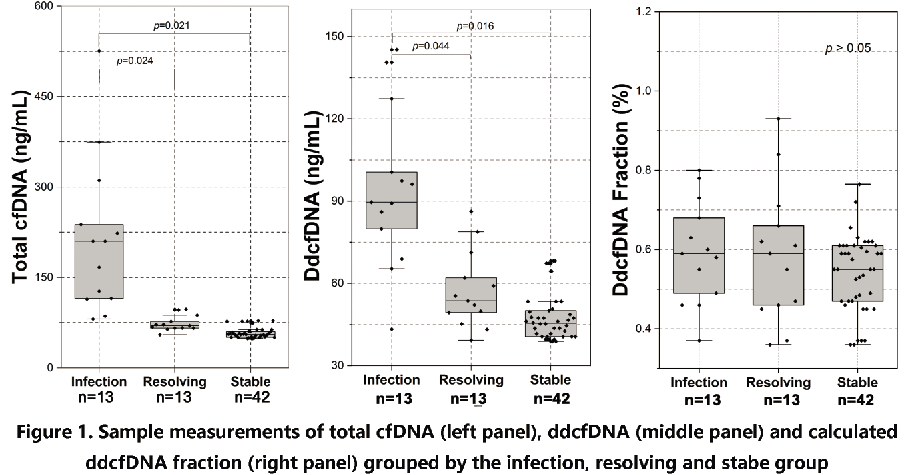The Level of Plasm Donor-Derived Cell-Free DNA in Kidney Transplant Patients with Severe Pneumonia
L. Liu1, H. Liu2, F. Liu2, L. Shu2, L. Peng1
1Xiangyang Hospital No. 2 of Central South University, Changsha, China, 2AlloDx, Shanghai
Suzhou, China
Meeting: 2020 American Transplant Congress
Abstract number: B-185
Session Information
Session Name: Poster Session B: All Infections (Excluding Kidney & Viral Hepatitis)
Session Type: Poster Session
Date: Saturday, May 30, 2020
Session Time: 3:15pm-4:00pm
 Presentation Time: 3:30pm-4:00pm
Presentation Time: 3:30pm-4:00pm
Location: Virtual
*Purpose: Pulmonary infection is one of the common complications after kidney transplantation. Donor-derived cell-free DNA (ddcfDNA) is a new biomarker to diagnose allograft injury. Currently, it is unclear how ddcfDNA levels change in kidney transplant patients with severe pneumonia.
*Methods: Through pathogen culture, immunofluorescence assay and qPCR assay, 13 kidney transplant patients were diagnosed with pneumonia (IDSA/ATS criteria) have been recruited, and paired plasm samples were collected on the 1st day of diagnosis (infection subgroup) and on the 7th day after treatment (resolving subgroup). Meanwhile, 42 patients at stable phase were selected as the stable group. Total cfDNA was extract from plasma and quantification by Qubit 3.0, ddcfDNA(%) quantification through target region capture sequencing and calculated by maximum likehood estimation (MLE). Set absolute quantification of ddcfDNA as copies per mL plasma (cp/mL) is calculated by multiplying the total concentration of cfDNA(cp/mL) by the ddcfDNA fraction (%).
*Results: 22 pathogens were detected, including 16 bacterial (i.e. PAE, ABA, KPN), 4 viral (i.e. CMV, EB), 2 fungal (i.e. Aspergillus, PCP). And detect negative on the 7th day of treatment.The mean of total cfDNA concentration in infection, resolving and stable subgroup was 222±78.9 ng/mL, 77±34.5ng/mL, 60±24.4ng/mL, respectively. Significant differences between infection group and resolving subgroup(p=0.024)/stable subgroup(p=0.021) was found, but no significant difference between resolving subgroup and stable subgroup (p>0.05).For fraction of ddcfDNA (%) analysis, the mean ddcfDNA(%) of three subgroups was 0.58%±0.12%, 0.58%±0.16%, 0.54%±0.08%, respectively. No significant differences exists among three subgroups (p>0.05). For absolute ddcfDNA quantification, the mean ddcfDNA(cp/mL) in aforementioned subgroups was 94.6±29.26cp/mL, 56.41±13.43cp/mL, 49.81±10.09cp/mL, respectively. Significant differences in the distribution of ddcfDNA were found between infection subgroup and resolving subgroup (p=0.044)/stable subgroup (p=0.016), but no significant difference between the resolving and stable subgroup (p=0.423). (Figure 1).
*Conclusions: Severe pneumonia can cause kidney injury, and increase absolute amount of ddcfDNA in plasma, but no change to fraction of ddcfDNA. The fraction of ddcfDNA could be diluted by activated lymphocytes caused by infection, suggesting that using ddcfDNA fraction to detect rejection, severe pneumonia does not affect the detection specificity of ddcfDNA.
To cite this abstract in AMA style:
Liu L, Liu H, Liu F, Shu L, Peng L. The Level of Plasm Donor-Derived Cell-Free DNA in Kidney Transplant Patients with Severe Pneumonia [abstract]. Am J Transplant. 2020; 20 (suppl 3). https://atcmeetingabstracts.com/abstract/the-level-of-plasm-donor-derived-cell-free-dna-in-kidney-transplant-patients-with-severe-pneumonia/. Accessed December 14, 2025.« Back to 2020 American Transplant Congress

